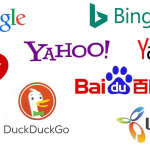Data takes the guesswork out of strategies.
You can go from “We should try this and see if people respond” to “Most people respond favorably to this strategy. Let’s also invest in it.”
We are bringing you the latest data on blogging. As you move through 2024 and beyond, use these blogging statistics to keep your blogging strategy current and focused on what users want most, optimized for the most popular devices.
General Blogging Statistics
Blogging is popular globally. Blogs account for 31.6% of 1.9 billion websites. Here are a few statistics to help you understand how popular blogs are and how people use this effective platform in marketing.
- There are over 600 million blogs in 2024.
- 93% of online experiences begin in a search engine. Blogging is your way to appear in search engines, attracting part of that traffic to your website.
- Google holds 85.55% of the global search engine market. They have roughly 83.79 billion visitors monthly.
- Every day, people publish over 2 million new blog posts.
- Blogging is very alive and active. About 77% of internet users engage with blogs.
- 80% of bloggers see strong marketing results, and those who publish regularly see the best results.
Blogging Growth Statistics
Not only is blogging alive and active, but it continues to see growth. Here are some projected growth statistics as we move through 2024 and beyond.
- Between 2024 and 2031, experts predict the SEO industry will grow at a CAGR of 25.54%.
- By 2032, the global content marketing industry should reach a $2 trillion market size.
- In 2024, 45% of B2B content marketers plan to increase their marketing budget.
- Blog post length has increased 42% over the past five years, showing the need for longer, more insightful content.

B2B Blogging Statistics
B2B blogging is a unique strategy as your audience tends to be more discerning and expect higher quality content.
- About 71% of B2B buyers read blog posts before making a purchase.
- 61% of B2B content marketers regularly meet with their content creation team, usually meeting daily or weekly. This additional alignment is crucial for B2B marketing as marketers often employ strategies such as account-based marketing that rely on a well-aligned team to craft personalized experiences.
- 58% of B2B marketers were able to increase their sales and revenue from content marketing in 2023.
- 66% of B2B marketers prioritize audience needs and pain points above conversion because B2B marketing builds relationships with loyal clients rather than make quick sales.
- B2B blog posts tend to be 12% longer than other blog posts.

Image from HubSpot
Blogging and SEO Statistics
Organic search is one of the main reasons marketers add blogging to their list of strategies. SEO prepares blog content for search engines to rank well in search results, generating higher traffic rates.
Here are a few statistics that give you insights into the interactions of blogging and SEO.
- Active blogs are rewarded with 434% more indexed pages and 97% more inbound links. The indexed pages and inbound links significantly improve a website’s search engine ranking, demonstrating the importance of keeping your blog active to generate consistent traffic.
- Blogs with 6-13-word headlines drive more traffic than shorter or longer ones.
- Google prefers updated, relevant content. That is why 34% of bloggers update their blog content regularly to strengthen their traffic results.
- About 75% of search engine users don’t look beyond the first search engine results page. In addition, 31% of users click on the first organic search result. Because of this startling number, marketers strive to snag one of those top search engine spots to see a healthy traffic stream.

Image from DemandSage
Blogging Content
What do people use their blogs for? These statistics will give you insights into how you can design your blog posts for the most engagement.
- The average blog is 1,416 words
- While most blogs have a higher word count, 75% of readers prefer blog posts that are 1,000 words or under. Yet, articles with higher word counts tend to lead to better results.
- Only 3% of bloggers regularly publish posts over 2,000 words.
- Despite the longer word count, the average reader only spends 52 seconds on a blog post.
- Consumers read blog content three times more than emails.
- About 44% of bloggers publish 3-6 times monthly.
- The most popular blog niches are food, lifestyle, and travel.
- The average blog post that does not use AI takes two to three hours to write.
- Half of bloggers publish weekly or more.
- About 61% of marketers host their blogs and websites on WordPress.
- Images are essential for engaging readers. Three-quarters of bloggers use between one and three images in their blog posts.
- When bloggers use images, they receive 94% more views than posts with no visuals.
- Video content is growing in popularity. Videos can drive 50 times more organic search traffic than text posts. Embedding videos into your blog posts to see the best of both worlds.

Image from SEMrush
Blog Readers Statistics
Who is writing and reading blogs, and is your audience among those readers? We gathered some of the most telling demographic details about blog readers and a few about blog writers.
- The average age of bloggers is 21 to 35 years old.
- The average age of Google users is 18 to 34.
- About 26% of Google traffic comes from the US.
- 59% of Google users are male and 41% are females.
Blog Marketing Statistics
While some bloggers use their blogs to generate income, it’s often just one of several content marketing strategies to promote a business’s products and services.
- About 90% of marketers use blogging in their marketing strategies.
- Blogging is a valuable source of new leads, with companies that blog generating 67% more leads than those that do not.
- Blogging is the third most popular marketing strategy. Video and eBooks are the first and second most popular strategies.
ROI of Blogging
- One of the biggest blogging challenges is accurately measuring ROI. Because blogging often doesn’t produce direct results, such as leading to a sale within the content, tracking the impact of blogging on sales requires more data and tracking the user journey.
- Most internet users (80%) say they engage with social media posts and blog posts, showing you have an active audience ready to engage with your posts if you are able to reach them through SEO and advertising.
- Blogging generates 55% more website visitors than static websites.
- The most popular way to monetize blogging is through Google AdSense. Affiliate marketing is the second most popular monetization strategy. High-income bloggers tend to sell their own products or services.
- Blogging investments tend to pay out what you pour into the strategy. On average, spending over $4,000 per post is 2.6 times more likely to see positive results than spending less than $500 per post. That cost includes a writer and a marketing team, a manager, a graphic designer, and an editor to ensure you publish top-quality content.
Blogging and Mobile Devices
How have mobile devices and new technology influenced blogging? Smartphones and voice assistants have shaken up blogging since content creators must now consider mobile browsing experiences and desktop viewers. They also need to account for voice searches when optimizing for search engines.
Use these statistics to help you invest in mobile optimization in a way that will most benefit your audience.
- Mobile devices generate 63% of the US’s organic search traffic.
- 8% of the global population own a mobile phone.
- Users browsing websites and blog posts on their mobile devices spend 40% less time on the site.
- If you plan to convert users using your blog posts, remember that 61% of consumers are likelier to purchase from mobile-friendly sites.
- About 25% of sales come from mobile devices compared to desktops.
Blogging and Social Media
Blogging and social media often work hand-in-hand to drive traffic to your website. Look at the current social media landscape and the future of this relationship.
- 96% of bloggers use social media to promote their blogs.
- 69% of bloggers allow readers to share their blog posts on social media.
Blogging and AI Statistics
AI is becoming increasingly popular in blogging. Its generative features allow businesses to write more in less time. However, there are also downsides to AI blogging, such as generic content, factual inaccuracies, and a lack of human emotion.
Here are a few statistics that will help you understand where AI is changing blogging and the potential future of blogging and AI.
- AI marketing can increase ROI by 70% because AI can create more efficient processes, cutting the costs of content creation and marketing.
- About 67% of marketers use AI in content marketing.
- About 58% of companies plan to incorporate an AI SEO strategy this year.
Put These Blog Statistics to Good Use
Blogging will not go anywhere anytime soon. It’s moving in the opposite direction, with significant growth expected over the next few years. Is your blogging strategy growing along with its popularity?
We can help you revitalize your blogging strategy, using the latest data and techniques to get the most eyes on your content.
Contact us to learn about our different content services and to find one that matches your needs.
The post 50+ Blogging Statistics to Guide You Beyond 2024 appeared first on Express Writers.













